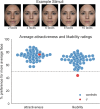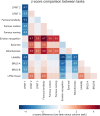The hidden identity of faces: a case of lifelong prosopagnosia
- PMID: 30670082
- PMCID: PMC6343346
- DOI: 10.1186/s40359-019-0278-z
The hidden identity of faces: a case of lifelong prosopagnosia
Abstract
Background: Not being able to recognize a person's face is a highly debilitating condition from which people with developmental prosopagnosia (DP) suffer their entire life. Here we describe the case of J, a 30 year old woman who reports being unable to recognize her parents, her husband, or herself in the mirror.
Case presentation: We set out to assess the severity of J's prosopagnosia using tests with unfamiliar as well as familiar faces and investigated whether impaired configural processing explains her deficit. To assess the specificity of the impairment, we tested J's performance when evaluating emotions, intentions, and the attractiveness and likability of faces. Detailed testing revealed typical brain activity patterns for faces and normal object recognition skills, and no evidence of any brain injury. However, compared to a group of matched controls, J showed severe deficits in learning new faces, and in recognizing familiar faces when only inner features were available. Her recognition of uncropped faces with blurred features was within the normal range, indicating preserved configural processing when peripheral features are available. J was also unimpaired when evaluating intentions and emotions in faces. In line with healthy controls, J rated more average faces as more attractive. However, she was the only one to rate them as less likable, indicating a preference for more distinctive and easier to recognize faces.
Conclusions: Taken together, the results illustrate both the severity and the specificity of DP in a single case. While DP is a heterogeneous disorder, an inability to integrate the inner features of the face into a whole might be the best explanation for the difficulties many individuals with prosopagnosia experience.
Keywords: Configural processing; Developmental prosopagnosia; Face perception; Object recognition; fMRI.
Conflict of interest statement
Ethics approval and consent to participate
All participants gave informed consent before taking part in the study, which was approved by the ethics board of Bielefeld University (ethics statement 2016–133).
Consent for publication
Written informed consent for publication of this case study was obtained from J. A copy of the consent form is available for review by the Editor of this journal.
Competing interests
The authors declare that they have no competing interests.
Publisher’s Note
Springer Nature remains neutral with regard to jurisdictional claims in published maps and institutional affiliations.
Figures







Similar articles
-
Neural decoding reveals impaired face configural processing in the right fusiform face area of individuals with developmental prosopagnosia.J Neurosci. 2015 Jan 28;35(4):1539-48. doi: 10.1523/JNEUROSCI.2646-14.2015. J Neurosci. 2015. PMID: 25632131 Free PMC article.
-
Developmental prosopagnosia: should it be taken at face value?Neurocase. 2001;7(1):15-27. doi: 10.1093/neucas/7.1.15. Neurocase. 2001. PMID: 11239073
-
The activation of visual face memory and explicit face recognition are delayed in developmental prosopagnosia.Neuropsychologia. 2015 Aug;75:538-47. doi: 10.1016/j.neuropsychologia.2015.07.009. Epub 2015 Jul 10. Neuropsychologia. 2015. PMID: 26169316
-
The cognitive and neural basis of developmental prosopagnosia.Q J Exp Psychol (Hove). 2017 Feb;70(2):316-344. doi: 10.1080/17470218.2016.1165263. Epub 2016 Apr 27. Q J Exp Psychol (Hove). 2017. PMID: 26967836 Review.
-
Developmental prosopagnosia: a window to content-specific face processing.Curr Opin Neurobiol. 2006 Apr;16(2):166-73. doi: 10.1016/j.conb.2006.03.003. Epub 2006 Mar 24. Curr Opin Neurobiol. 2006. PMID: 16563738 Review.
Cited by
-
Consciousness and sleep.Neuron. 2024 May 15;112(10):1568-1594. doi: 10.1016/j.neuron.2024.04.011. Epub 2024 May 1. Neuron. 2024. PMID: 38697113 Free PMC article. Review.
-
Evidence for normal novel object recognition abilities in developmental prosopagnosia.R Soc Open Sci. 2020 Sep 23;7(9):200988. doi: 10.1098/rsos.200988. eCollection 2020 Sep. R Soc Open Sci. 2020. PMID: 33047056 Free PMC article.
References
Publication types
MeSH terms
Grants and funding
LinkOut - more resources
Full Text Sources
Molecular Biology Databases

